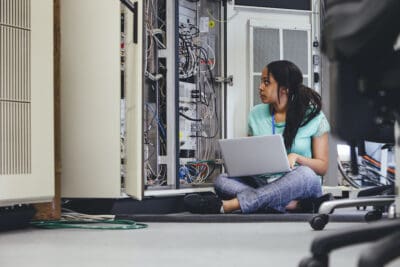
Policy at JFF
JFF’s policy team offers fresh ideas on education, poverty alleviation, and workforce issues that prepare students and workers for the jobs of the future and boost our nation's economy. JFF’s policy team offers fresh ideas…

July 27, 2021
We must invest in America’s workers. As Congress and the Biden administration pursue investments in infrastructure and further recovery efforts, JFF urges policymakers to fund workforce development at the $100 billion level outlined in the president’s American Jobs Plan.
JFF urges Congress to fund workforce development at the full $100 billion proposed by President Joe Biden in the American Jobs Plan (AJP).
As federal policymakers work to achieve a bipartisan agreement on infrastructure and on further legislation that will support job creation and economic recovery, it is critical that we also invest in America’s workers. It is essential for creating an economic recovery that is truly equitable.
More than 9.5 million people are still out of work in this country, and the total is even higher when discouraged and underemployed workers are counted. Recent labor market data also continue to show alarming differences in unemployment by race and ethnicity. While the national unemployment rate is 5.9 percent, Black and Latinx populations face significantly higher unemployment rates of 9.2 percent and 7.4 percent, respectively.
The $100 billion the president proposed in the AJP would provide critical services to workers who lost their jobs as a result of the pandemic, especially workers in low-paying jobs. It could help them to build new in-demand skills and advance in the economy.
This level of investment is key to ensuring that the country can continue to rebound from the economic crisis. However, we are hearing that the president’s proposed $100 billion in funding may be vulnerable to reductions to accommodate competing priorities in future recovery bills.
Now is the time ... to champion one of the most critical workforce policy decisions since the GI Bill, with a focus on [ensuring] an equitable recovery.
At this moment of ongoing economic distress, now is the time for all workforce stakeholders to take a stand—to champion one of the most critical workforce policy decisions since the GI Bill, with a focus on supporting those who have been hardest hit and helping to ensure an equitable recovery.
Even before the pandemic, the United States faced severe shortages of workers with the skills and technical credentials needed for in-demand jobs. We expect this shortage to persist as new ways of working continue to evolve, sparked by technological advances that spur demand for people with higher-level knowledge, skills, and abilities. Many workers displaced by the pandemic were in occupations that paid low wages and didn’t require the same types of skills as jobs in emerging sectors with opportunities for career advancement. Those individuals are at a distinct disadvantage in the current labor market.
Today’s jobseekers need access to high-quality career navigation and skill development opportunities to prepare for the new jobs that are being created and for the jobs that have been difficult to fill for the past 10 years in fields such as in IT, cybersecurity, advanced manufacturing, and health care.
It’s also important to note that most of the jobs that will be created through expected infrastructure investments in the coming months will not require four-year degrees. Instead, they will require skills and occupational credentials that workers can acquire in short-term training programs. If we don’t invest in the workforce system now, these new jobs will be out of reach for the millions of Americans most impacted by the pandemic, including people of color, women of all races, and others facing barriers to employment.
We must learn from this crisis and harness the momentum that continues to build behind recovery efforts.
In recent weeks, much has been made about the idea that people are refusing to reenter the workforce because they are receiving federal unemployment assistance provided through COVID relief packages. If it is true that people are getting paid more to stay home than they would earn in many available jobs, maybe we should focus on ways to improve the quality of those jobs and on ways to help people build the skills needed to transition into other in-demand careers that pay family-supporting wages.
We must learn from this crisis and harness the momentum that continues to build behind recovery efforts.
Our national workforce and job training experts would agree that this sort of massive investment would barely catch us up to our European counterparts and global competitors who have invested much more in their workers for the past 30 years. Now is the time for significant investments in our nation’s workforce ecosystem to immediately address and respond to the massive economic dislocation of the last two years, the rapid technological advancements in the workplace, and the changing social and racial justice issues so evident in the workplace.

JFF’s policy team offers fresh ideas on education, poverty alleviation, and workforce issues that prepare students and workers for the jobs of the future and boost our nation's economy. JFF’s policy team offers fresh ideas…

JFF urges leaders in Congress and the Biden administration to adopt policies that revitalize and overhaul the U.S. workforce and postsecondary education systems. JFF has developed a list of nine steps policymakers can take to…

With the country seeking a path to recovery from the COVID-19 pandemic and the economic crisis it caused, JFF calls on the Biden administration to work toward three goals: helping all people rebound and advance,…